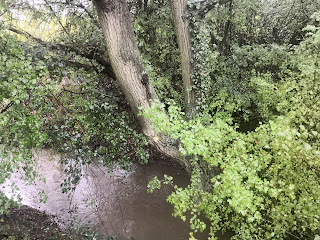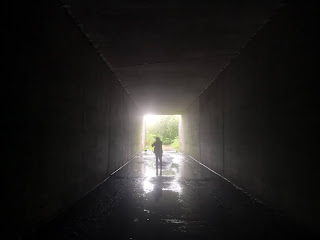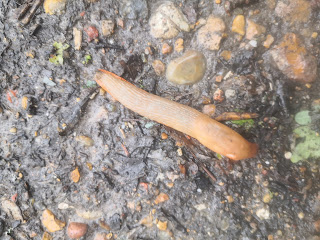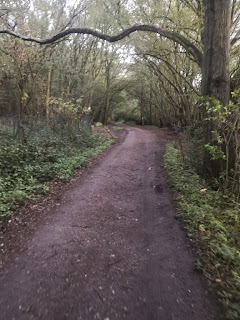"From God to local bobby, in home and street and school, they've got your name and number while you've just got their rule. We've got to look for methods to undermine those powers. It's time to change the tables. The future must be ours" - Big A Little A, Crass.
Growing up in Tadley in the seventies and
eighties,
punk was big - and no
punk band was bigger than Crass. A noisy, poetic, artistic, subversive anarcho-punk syndicate who lived in a large country house in
Essex and whose records sold in droves but never made the pop charts. Stickers on the sleeves would demand you pay no more than 49p or 99p and when you pulled the gatefold sleeves open there would be edgy artwork and lengthy lectures about animal rights, the military-industrial complex, and the morally bankrupt, though sadly still dominant, worldview of
Thatcherism.
Crass, along with others, helped show me the path away from capitalism. Away from thinking that life should be judged by how much money, how many possessions, a person has. Life was more than a game of Monopoly. The point of it was to live it, to experience it - not use it to amass a huge pile of gold coins and a large house and family you'd never see because you're forever in the office.
Of course, things are a little more nuanced than that but Crass, and - again - others, at least showed there was another way of doing things. I still listen to some of their records now and I still like most of their message but it had never occurred to me, until late last year, to visit their former HQ, Dial House in North Weald Bassett. When I sat down to draw up
the 2020 TADS timetable (
one I could have no idea just how much it would be disrupted) I popped it in for October,
we like to do an edgelands walk that month, and then sat about devising a walk around it. Knowing that a brief look at a house would not, on its own, entice many others out.
The week running up to yesterday's Stations of the Crass walk saw some pretty bad weather, a lot of rain that looked like it had no intention of stopping by Saturday so it's perhaps not a surprise that Rachael dropped out the night before and then
Shep, Teresa, and
Kathy on the morning of the walk. None of them blamed the weather and all had perfectly valid reasons (and nobody should ever feel obliged to attend anyway) but if they had said they just didn't fancy getting drenched I wouldn't have blamed them.
It turned out that
Pam,
Adam, and myself weren't so bothered about the rain and even convinced ourselves, rightly it turned out, that it wouldn't be too bad and wouldn't last all day. I'd set off from Honor Oak Park at roughly 8am, taken a rail replacement service bus to New Cross Gate, the Overground to
Whitechapel, the District Line to Mile End, and, finally, the Central Line out to Theydon Bois. A place I'd previously visited to go paintballing on my friend Tony's stag day. It being Tony's birthday weekend, a revisit seemed appopriate.
I was the first to arrive in Theydon Bois and popped in a shop to grab a Guardian (in
Essex!?) and a packet of Bobby's salt'n'vinegar Spirals (which would appear and then disappear quite quickly early in the walk) before crossing over to the delightful Bonhomie to wait for
Pam and Adam, who both arrived promptly, and enjoy a lovely breakfast of scrambled egg and baked beans on toast. It was a fancier joint than the greasy spoons we tend to frequent but service was friendly, my food was tasty, and Pam's avocados looked pretty good too. We managed to resist the temptation of a breakfast mojito or pina colada.
Fed, watered, and having caught up with each other's news (family and work are the gifts that keep giving on that score), we headed out for one of
the most poorly attended TADS walk in
TADS history. Which was a shame as it was, as
TADS, our first ever time in Essex.
What the walk lacked in quantity of attendees however it made up for in quality. Both Adam and
Pam (and, eventually, myself) were well up for a day's walking and we were soon joined by a fox as we passed over a bridge across the Central Line and a bunny rabbit in the field that the bridge took us down into. It wasn't the last bunny rabbit of the day and as the afternoon dragged on it would be joined with cats, cows, and horses a plenty.
Theydon Bois is a pleasant if unremarkable place. Disappointingly Bois is pronounced 'boyce' or 'boys' and not 'bwah' as many of us had assumed in the past. It's named for the de Bosco family who held the manor in the 12/13c and it was only when the Great Eastern Railway built the line out to Ongar that the spelling was formalised. A clerk of Epping Parish Council, a Mr John Windas, had some basic knowledge of the French language and suggested B-O-I-S and that it remains.
It's not a thrilling place. Annual highlights are said to include a donkey derby and an open garden day and the main sight is the Avenue of Trees, some distance from the station on Loughton Road, which features, you guessed it, an avenue of trees planted in the 1830s to celebrate Victoria's ascent to the throne.
It didn't seem worth a detour as we had a decent length walk ahead of us anyway. Passing through some soggy but picturesque fields and with the roar of both the M11 and the M25 in the distance we soon reached an underpass beneath the aforesaid of those motorways and not only was it dark but the floor was covered in a puddle for the entirety of its length.
I went first and got my inappropriate footwear, trainers, soaked and then my socks and feet too. They'd remain squelchy for the next hour or so and when I got home at the end of the day my poor little tootsies absolutely honked. Pam passed through quietly and uneventfully and Adam took the dramatic measure of removing both his boots and socks and wading through.
The underpass brought us out, via fast flowing muddy streams, into a field of nonchalant horses and past the 13c Anglican church of All Saints and into the village of Theydon Garnon (Theydon is believed to mean 'valley where thatch grows' and Garnon derives from a family called Gernon.
We reached reasonably evocative fingerposts, passed through a small industrial estate with a desk facing a skip looking like a metaphor for the depressing nature of office life, and turned left and passed under a thankfully much drier underpass beneath the M25.
Here we met with open fields on one side and thick forest to the other. One anaemic slug crossed our path and a long straight stretch brought us to a T junction and a lengthy though not problematic section along quiet country lanes, remarkable to think we'd not long left a tube station and we were already among small country hamlets and homely cottages.
Some of the cottages were beautiful, others more ostentatious than anything, but all of the nature, though not as spectacular as
our recent visit to the Wye Valley, was aesthetically pleasing. Gently rolling hills, dewy green fields, and slightly slippy muddy ploughed fields. One of which we'd soon be passing through, finally away from the road, until we reached the small settlement of Toot Hill and its Green Man pub.
Adam, who was a bit ahead at this point, informed us we should rush as they were playing Come On Eileen but we missed that. The pub was nice though. Outdoor seats were either wet from the rain or already taken so we took a seat inside and the barmaid brought us an IPA (Pam), a London Glory (me), and a Moretti (Adam). We supped them beneath an image of Goodfellas and they went down so well, and the service was so friendly, we had seconds. Pam switching to gin and presenting me with a brilliant late birthday present, a kind of tube map for walkers that shows how many of
London's green spaces link up. It will surely become a valuable research tool.
Leaving The Green Man, and stopping - again - briefly - to admire another fingerpost and ponder what Bobbingworth and Stanford Rivers might be like, it wasn't long before we'd left Toot Hill and The Green Man and I quickly remembered to inform my fellow walkers that Toot Hill was the former home of Olly Murs and that The Green Man burned down in 1896 and was rebuilt in 1907.
On quiet Mill Lane, an overexcited dog gave us all a smile and we soon reached a
brutalist water tower and I pondered the idea of organising a rustic/rural brutalist walk. Everyone knows about
the brutalist buildings of large cities but less attention is paid to just how many iconic examples of brutalism populate the countryside, not least in places like the Essex edgelands.
At the water tower we took a ninety degree right angle turn and headed north, beneath a photogenic railway bridge, to Dial House itself. The reason for the walk. I had expected to be a little disappointed, it is just a house after all, but found myself strangely excited by the 16c homestead that has served as the home of the writer Primrose McConnell (whose 1883 tome, The Agricultural Notebook, is a standard reference book for the European farming industry) and, from 1967 onwards, to a self-substaining anarchist-pacifist house that, as I established earlier, was the home of Crass from 1977 to 1984.
To this day it still hosts avant-garde
jazz movements and founders of
free festivals though when we arrived it was pretty quiet. It seemed as if nobody was in so we took a few
photos, admired the wooden sculptures and signs (one written in a very Crass font) that decorated the exterior of the grounds and peered into the large and labyrinthine gardens themselves. We were pleased to see free apples and pears being given away, Pam tucked into a pear, but less impressed with the Amazon delivery waiting on the doorstop in direct contravention of Dial House's instructions to leave parcels in a box at the gate and possibly also of the entire ethics behind Crass and Dial House.


Ah well, they do say never meet your heroes and if I didn't meet Penny Rimbaud of Steve Ignorant I did get to see the place I most associate with them and it had felt good to do so even if, even now, I'm still wondering what was in that Amazon parcel.
Neighbouring Dial House is a sprawling farm. Cattle wandered over to check us out, a scrawny black cat too, and the hay had been stacked up in a way that was highly pleasing to both Pam and my own artistic sensibilities.
From here a path of cracked concrete surrounded by shrub and bushes took us, now with the sun shining, along to the edge of the North Weald Redoubt, a regular sight of ghost spottings which, due to it sadly being in private hands, we could only look at from the paths.
Even that didn't work for us. All we saw was a few concrete boulders which, Adam believed - and the ditches dug next to them seemed to confirm, have been put there to stop travellers settling on the flat common ground that there's so much of. North Weald Redbout's full name is the North Weald London Mobilisation Centre and it's one of the more substantial parts of a series of defensive positions that stretch seventy-two miles and were built to protect London from invasion by the French who had, at the time of its building, been modernising their army following defeat at Waterloo.
It's hard to work out why the French would come into London from a northern outpost like Epping. Perhaps when I read the book Strange Labyrinth by Will Ashon, a gift from my lovely friend Jack for my birthday this year, there will be something about it in there.




After stopping to lark around with some fine nags, one of whom Adam named Buttercup and seemed to develop quite a crush on, we continued along the path and stopped briefly to talk to a local dog walker who remarked how keen he was to see ramblers in the area, told us about preservation schemes he'd been involved in, and ended our chat by boasting that he'd that morning received a refund from Ryanair!
We were now on the edge of, and we were soon in, North Weald Bassett itself and just as the rain started up, quite heavy at one point, we hit The King's Head pub, the oldest in the area and a very pleasant, and timely, pit stop. Adam and myself had a lager, Pam a gin, and we admired the
needlepoint on the walls and the Tudor architectural quirks while our conversation took us down memory lane recalling our friends ex-partners and deciding which ones we'd liked and which ones we'd not been so keen on. A proper little gossip basically.



I'd have been tempted, quite easily, by yet another two pint mistake but smarter heads prevailed and with the rain now stopped that was the right decision. We soon left North Weald Bassett and our path took us through some long and rather lovely wooded trails, the sun beginning to set and imbuing the surprisingly pastoral scene with a highly pleasing golden glow.
This path took us, eventually and pleasantly, over the M11 (with spectacular views of the shadowy skyscrapers of London on the horizon) and into the pleasant suburban village of Coopersale. It was hard to believe we were only one mile away from a tube station.
I'd planned a stop for a pint at The Garnon Bushes in Coopersale and it looked, despite the large screen showing football, a nice pub but Adam wanted to get home early and said he'd prefer to push on to Epping and have a curry (and another beer) rather than do a pub stop. With Pam in accordance I was outnumbered (again) but that wasn't a bad thing. The Garnon Bushes was nice to look at. We don't necessarily have to go in EVERY pub we pass.



The area around Coopersale and Garnon Bushes has been used, historically, for farming wheat, barley, and beans and is home to the flat church of St Alban the Martyr. It's got a pleasant, relaxed, and not too stuffy suburban vibe and it looks like it'd be a good place to live. It was an easy place to walk through. A couple of suburban side streets led to a diagonal path that passed over the now disused tube line from Epping to Ongar and out on to a playing field, where we had a blast of 54-46 Was My Number and Pressure Drop, to mark the passing of reggae legend Toots Hibbert, and soon enough into the centre of Epping.
Twinned with Epping in Baden-Wurttemberg (capital:Stuttgart) in 1981, Epping began as a small community of scattered farms and developed into a small town overnight stop for stagecoaches and mail coaches coming to
London from Norwich,
Cambridge, and Bury St Edmunds. It's actually quite small and its notoriety most likely stems from being on the end of a tube line and, far more so, the much larger forest which, one day, we should explore in far greater depth.
Notables associated with Epping include Dave Gahan, Nick Berry, Glenn Hoddle, Rod Stewart, Bradley Walsh, Jessie Wallace (Kat Slater in Eastenders), Lisa Snowdon, Sheridan Smith, Philip Hammond, Griff Rhys Jones, and Winston Churchill who was MP for Epping between 1924 and 1945. You'll not be surprised to learn that Epping, as with every other part of Essex, is still in Tory hands. With those MPs including Priti Patel, Mark Francois, Bernard Jenkin, and James Cleverly it makes me think that, despite it being very beautiful, I'd never want to live there.
To eat there is fine though. Back in 2014 Shep and myself walked from Snaresbrook to Epping in some kind of forerunner to what would become
TADS and we ended up in Zaikaa. We ended up there again. In lieu of Shep's absence I had a paneer shashlik and a cheese and chilli nan washed down with a brace of Cobras (no Bangla), Adam had a veggie dansak, and Pam stir-fried spinach and sweet pumpkin with garlic and coriander.
It wasn't exceptional but it was decent and it went down well after a reasonably long day's walking (33,779 steps notched up by phone) and the conversation was as interesting and funny as ever. Adam shot off early so Pam and I took a leisurely stroll to Epping tube station. I hopped off at Mile End, and via
Whitechapel,
Peckham Rye, and, eventually, the 363 bus I was home just before midnight. The smell of my feet will not linger in the mind as long as the memories of a walk that, despite all indicators - weather, people dropping out,
Covid - turned out to be a rather special little day out.
Thanks to Pam and Adam for the snappage and the mappage and most of all, as ever, the great company on a walk that may have started out wet and unpromising but soon proved, again - as ever, to be a wonderful pick me up. Where next Columbus?






































































































































No comments:
Post a Comment